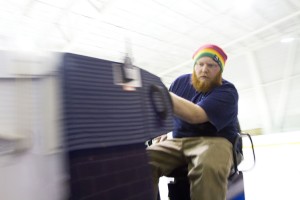From first dates to ward activities and family outings to club hockey, it seems like someone is always on the ice at the Seven Peaks Ice Arena.
But while local patrons glide playfully around the rink, a man works hard behind the scenes to maintain the quality of the ice.
He is a burly, lumberjack looking fellow with a thick, fire-red beard and a rainbow-colored ski hat who knows the ice better than anyone else in the building.

Meet Patrick Kane, the Zamboni driver at Seven Peaks Ice Arena.
Kane, 27, grew up in Burlington, Vt., where ice hockey was more popular than other sports.
“If you didn’t go to a football game, nobody noticed,” Kane said. “But if you didn’t go to a hockey game it was like, ‘Hey man, how come you weren’t at the game?’”
Although Kane never played hockey, he described himself as a “ruthless fan” of the sport in high school. That love of hockey landed him a job at his local ice skating rink, where he learned the basics of rink maintenance.
“Just being around at a hockey rink, you learn about different programs and how the ice should look,” Kane said.
Kane learned to drive a Zamboni when he moved to Utah. Zamboni is a brand name of an ice-resurfacing machine invented by Frank Zamboni, a Utah native, in 1949. The vehicle has become essential to not only the hockey game, but also to the culture, and was mentioned in Martin Zellar’s song, “I Wanna Drive the Zamboni.”
Zambonis essentially pave ice over ice arenas. The arenas are built on concrete bases over an intricate maze of cooling pipes. The ice is generally an inch to one-and-a-half inches thick, applied in layers by the Zamboni.
“It takes about 70 laps to get about an inch of ice,” Kane said. “It takes a lot of work.”
One “lap” is equal to an entire resurfacing session with a Zamboni.
Each of the two rinks at Seven Peaks Ice Arena is resurfaced from the ground every other year during the summer, and the process can take several days. The more important ice maintenance comes between each skating sessiona, when Kane takes the Zamboni out for a resurfacing lap to smooth over the rough ice.
Prior to the invention of the Zamboni, ice had to be resurfaced by hand and the process often took about 24 hours.
The machine first cuts the ice with a large razor blade. Ice shavings are fed through a system of corkscrew augers to the front container on the Zamboni. A stream of water then cleans the newly shaved ice to remove any impurities. This water is collected and filtered within the vehicle.
The part that spectators see is the resurfacing water steaming over the back edge of the Zamboni, creating a clear and smooth coat of ice for the next round of skaters.
Kane drives the Zamboni in a specific pattern to make sure he doesn’t miss a spot, and he usually can resurface within an inch of the boards, letting the water flow to the edges of the rink on its own.
At the end of each resurfacing lap, Kane returns the Zamboni to the garage as patrons return to the ice, carving new paths over the freshly resurfaced rink. Kane again works hard behind the scenes emptying, cleaning and refilling the Zamboni for the next round of resurfacing that needs to be done.
“(Patrick) does it really well,” coworker Nicki Santamaria said of Kane’s resurfacing techniques. “He takes his time with it.”




